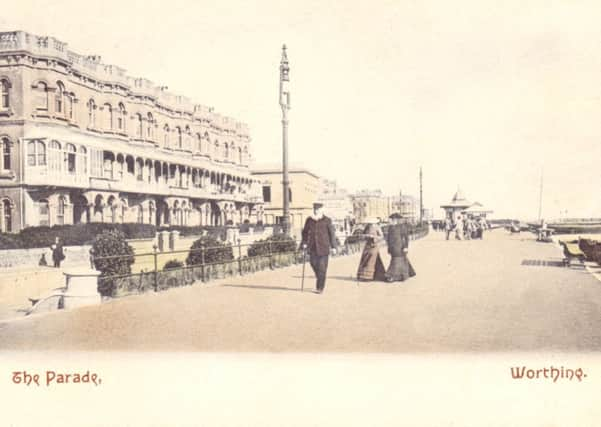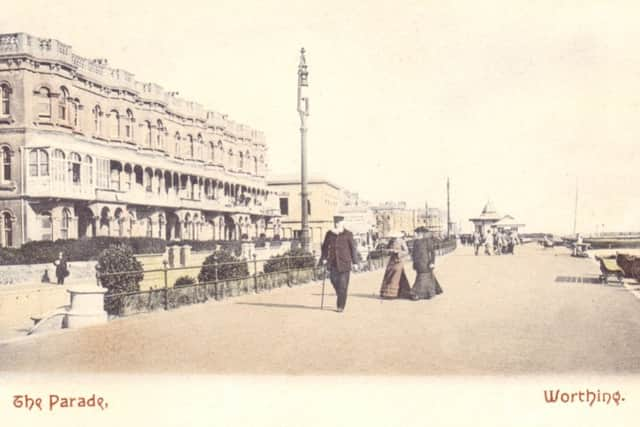Mezzotint of Brighton – and the Worthing Motor Carnival of 1905


This month’s publisher was relatively minor in Worthing terms, producing perhaps only two or three dozen different views of the town and its hinterland.
However, they are particularly atmosphere cards, and immediately recognisable from the unusual and characterful type-face that was used for the captions during the period when the firm’s production was at its height.
The firm in question was the Mezzotint Company of Brighton.


Advertisement
Hide AdAdvertisement
Hide AdAt Rendel Williams’s superbly researched Sussex Postcards website – www.sussexpostcards.info – there is a detailed history of the company, from which the information in the next few paragraphs is drawn.
Mezzotint, which had a printing works at the junction of London Road and York Hill in Brighton, began issuing cards in 1901.
Although the firm published mainly cards of Sussex – its reach extending to Balcombe and Three Bridges in the north, Uckfield and Hastings in the east, and Arundel and Selsey in the west – it also published postcards of a few locations elsewhere in Britain.
According to Williams, sales of Mezzotint cards reached a peak in 1905 and then began a long decline, until the firm ceased trading around 1912.
Advertisement
Hide AdAdvertisement
Hide AdThis finding is borne out by the postmarks on the Mezzotint cards in my own collection; and indeed all five cards reproduced here were posted between May, 1905, and March, 1906.
Williams says that Mezzotint’s hand-coloured cards could be very attractive, but often were rather poorly done. The cards in this selection demonstrate both elements.
At first sight, the delicate, pastel colours work well – and indeed perhaps first sight that is all that matters, since few of the recipients will have studied the cards in detail.
Those that did would, however, have found that the colours are often rather crudely applied, the postcard of the Motor Carnival being a good example of this.
Advertisement
Hide AdAdvertisement
Hide AdThe immediate effect is successful, but those that look closely will see that most of the buildings are still black and white, as in the original photograph.
The strip of green and the dots of blue and red initially deceive us into thinking that we are looking at a full colour image.
This card is of particular interest, because it was taken on the day of the Worthing Decorated Motor Carnival and Battle of Flowers, which was the town’s most successful attraction in 1905.
The event was organised by George Warne, the proprietor of Warne’s Hotel, who three years earlier had organised a motor “trial” from Crystal Palace to Worthing, for which his hotel had served as the lunch stop.
Advertisement
Hide AdAdvertisement
Hide AdThe 1902 event attracted about 250 competitors, but the event of 1905, held on April 24 – Easter Monday – was even bigger, with over 300 cars and motorcycles.
Fourteen prizes were offered for the best decorated cars and motorcycles.
The car competition was won by Hector Morison, a stock-broker and prominent Liberal, who stood as the party’s candidate for Lewes in the 1906 General Election and for Eastbourne in the two elections of 1910, before serving as MP for Hackney South from 1912 to 1918.
All the cars were decorated with flowers, and – as can be seen in the photograph at bottom right – Morison’s car featured an outsize swan on top of the engine.
Advertisement
Hide AdAdvertisement
Hide AdAccording to Tony Gardiner, in his book The Brighton National Speed Trials, George Warne’s initiatives may have been the inspiration for Brighton to organise its own trials, the first of which was held on July 19–22, 1905, three months after Warne’s Motor Carnival.
It would appear, therefore, that the London to Worthing run of 1902 was the original historic event – and that the London to Brighton run, still held today, was an act of automotive theft!
The postcard of the Motor Carnival was sent on December 30, 1905, by Annie, who lived in Market Street – which sadly, like Warne’s Hotel, is long gone, apart from a short section that remains at the Chapel Road end.
Annie’s handwriting is quite graceful, but the total absence of full stops makes it difficult always to be certain which phrases belong to which of her statements. I conjecture as follows.
Advertisement
Hide AdAdvertisement
Hide Ad“A line to say I wish you a Happy New Year. [I] shall be able to write if all is well [on] Monday. [At] my afternoon place the people are gone away, so I don’t go now. Not heard from Jack as yet. Love from Annie.”
What, one wonders, was Annie’s afternoon place? And why had the people gone away?
• Antony Edmonds is the author of Worthing: The Postcard Collection (Amberley, 2013).